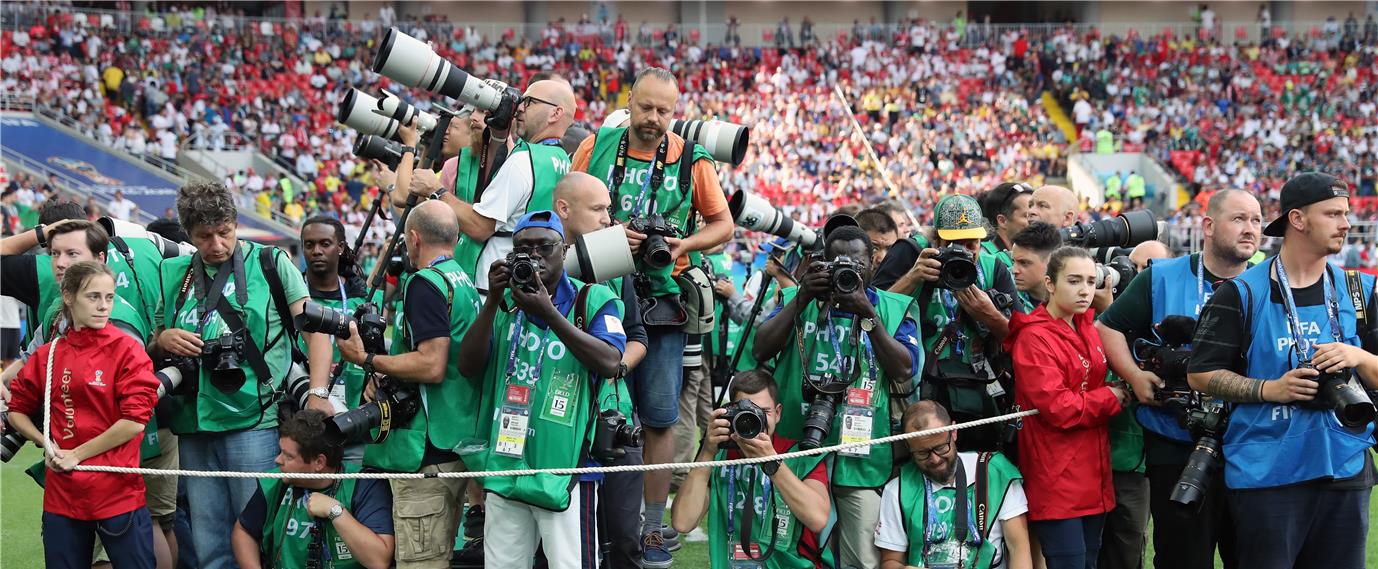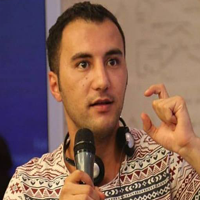دخل الصحفي السوري هُمام كدر عالمَ الإعلام الرياضي منذ العام 2006، وعمل في عددٍ من المواقع الإلكترونية. وفي عام 2011، شقَّ كدر الذي درس في كلية الإعلام بجامعة دمشق، طريقه نحو شبكة قنوات "بي إن سبورتس" (الجزيرة الرياضية سابقاً)، وهو التاريخ الذي غادر فيه بلاده. واليوم يعمل صاحب الـ35 عاماً صحفيا في الموقع الإلكتروني لشبكة قنوات "بي إن سبورتس".
تحدّثت "مجلة الصحافة" مع كدر للوقوف على واقع الإعلام الرياضي في العالم العربي، وخصوصية مزاولة هذه المهنة، والتحدّيات التي تواجه الصحفيين العاملين في الشأن الرياضي، إضافةً إلى تأثير الرقمنة الإعلامية في العمل الإعلامي الرياضي.

خصوصية العمل في الرياضة
كغيره من الاختصاصات الإعلامية، ينفرد الإعلام الرياضي بخصوصية تمثّله وحده رغم عدم خروجه عن القوالب الإعلامية الأساسية المعمول بها في المهنة. وتتعلّق هذه الخصوصية بالرياضة في حدِّ ذاتها، وما تتطلّبه من لغة خاصة ومرونة في العمل.. "العمل الإعلامي في الحقل الرياضي مثير للغاية، فهو واحد من أكثر التخصصات الصحفية الحيوية، والحيوية صفة متأصلة في الصحفي قبل أن يشق طريقه نحو الاختصاص"، يشرح الصحفي همام كدر عن الخصوصية.
ويتابع "الصحفي الرياضي يُطبع بطابع المنافسات، على أساس السرعة والرشاقة في التغطية، وكتابة الأخبار تحت الضغط"، مُضيفاً: "ما زلتُ أذكر تمارين الدكتور أديب خضور في جامعة دمشق (قسم الإعلام قبل أن يتحول إلى كلية)، عندما كان يدرّب الطلّاب على تحرير الخبر الرياضي، وتحديداً خبر مباراة كرة القدم، لأنه يحتوي على كل العناصر الخبرية المثالية، فحين تذكر نتيجة الفريقين المتنافسين، والملعب (المكان)، والمناسبة، والتاريخ، فإنك تجيب عن الأسئلة الستة التي تشكل أساس الخبر.. الخبر الذي هو أساس أي صحفي".
واستطرد كدر في الحديث عن آنية العمل: "حالياً نحن نتعامل بالثواني، ومطالبون بالنشر على أكثر من منصة في الوقت عينه، وبتفاصيل التفاصيل".
يشعر كدر أنه محظوظ لأنه عاصر الفترة التي كان ينتظر فيها جريدة الثلاثاء ليعرف تحليل المختصين عن مباريات السبت والأحد، قبل أن تصبح حقائق وأحداث المباريات تصله فور حدوثها بفضل التطبيقات الحديثة، حتى أسرع من البث المباشر المتلفز.. "علينا أن نستوعب كل التغيّرات التي حدثت في الصحافة والانتقال، فسابقاً كان الصحفي يكتب الخبر ويرسله إلى الجريدة عن مباراة اليوم ليُنشر في عدد الغد.. تخيلوا هذه المسافة الزمنية الطويلة إذا ما قارنّاها بالإعلام الحالي"، موضحاً أن كل من عاصر هذين الزمنين في تناول وسائل الإعلام للأحداث الرياضية سيشعر بالغنى.
جمهور نوعي للرياضة
يرى كدر أن خصوصية الإعلام الرياضي لا تتوقّف عند العمل به فحسب، بل تمتد إلى الجمهور المتابع للرياضة، ويقول: "هناك خصوصية كبيرة للجمهور الرياضي، فهو جمهور ذكي للغاية ومتابع لكل صغيرة وكبيرة".
ويوضّح أن حذاقة الجمهور أدّت إلى وجود تداخل بين عمل الصحفي الهاوي وعمل الصحفي المحترف، وهو ما زاد من التحديات التي تُفرض أمام الصحفي المحترف.
وبات الآن بمقدور جمهور الرياضة الوصول إلى المعلومات والأرقام كحال الصحفي الرياضي تماماً، حتّى إن الصحفيين المحترفين باتوا يستقون هذه المعلومات والبيانات والأفكار من منصات الإعلام الحديث التي يديرها هواة، حسب كدر الذي قال أيضاً: "ربما ليست هذه المنصّات في أغلبها احترافية، ولكن بعضها يحركنا للتحقق والتوسع".
وغير بعيد عن واقع الجمهور، فإن الرياضة وكرة القدم تحديداً تعزز الشعور القومي للناس، فهناك دول تشتهر لأن منتخبها الوطني تأهل إلى كأس العالم، مثل جامايكا في مونديال 1998 وبنما عام 2018، وفقاً لكدر الذي تابع قائلا: "ميدالية أولمبية واحدة من أي معدن تعرّف ببلد صاحبها عند ملايين من الناس، وهذه حقيقة لأن أرقام المشاهدات في كأس العالم ودورات الألعاب الأولمبية تكاد تفوق أي حدث آخر، رياضيا كان أو غير رياضي".
ويشدّد كدر على ضرورة عدم الخلط إعلامياً بين الدول والمنتخبات، وهنا يجب القول: "فاز منتخب إنجلترا مثلاً على نظيره الفرنسي" بدلاً من قول "فازت إنجلترا على فرنسا".

بين الخبر والتحليل
يُعتبر العمل الإعلامي في القسم الرياضي من أكثر الاختصاصات الإعلامية التي يتداخل فيها الخبر مع الرأي مع التحليل، وهو ما يشكّل خلطاً كبيراً في الأنواع الصحفية. وفي هذا السياق يوضّح كدر أنه في الإعلام الرياضي هناك فرق بين الصحفي والمحلل، لكون العمليْن ربما يقوم بهما الصحفي، لذلك يتداخلان بشكل كبير.
وقال: "ليس المطلوب من الصحفي ألا يحلل المباريات، بل المطلوب ألا يخلط بين كتابة مقال الرأي وغيره من الأجناس الصحفية، وأن يقدم نفسه لقارئه منذ بداية المادة على أنه محلل أو صحفي يقرأ حدثا ما".
وشدّد كدر على أن تنوّع منصات النشر الرقمية زاد من ضرورة استخدام المنصّات المناسبة في الإعلام الرياضي لتقديم الجنس الصحفي المناسب لقرّائها، فعلى سبيل المثال يُستخدم موقع التواصل "تويتر" من أجل نشر الحقائق السريعة والانطباعات المباشرة، في حين يُستخدم موقع "فيسبوك" من أجل الأفكار الأكثر توسّعاً وتفصيلا، ويوتيوب من أجل التحليل المصوّر، وذلك لكون الإعلام الرياضي يعتمد على الصورة التي تُحلَّل في المباريات.
منصات إعلامية للهواة
شهدت السنوات الماضية "طفرة" في المنصّات الإعلامية الرياضية التي يُطلقها هواة وأناس عاديون يحبّون الرياضة، حتّى بات التفريق بين أسمائها أمراً غاية في الصعوبة.
ورغم عدم وجود صحفيين محترفين يقفون خلف هذه المنصّات، فإنّها حقّقت متابعات واسعة فاقت في بعض الأحيان المتابعة التي تحصدها وسائل الإعلام الرياضية المتخصّصة، بسبب قدرة القائمين على هذه المنصّات على تقديم المحتوى بشغف قرَّبهم من الجمهور.
غير أن الصحفي هُمام كدر يرى أنَّ ظهور هذه المنصّات أمر إيجابي، على الرغم من أنَّ انتشارها أزعج الكثيرين. ويدلّل على رأيه بأنه لطالما كان هدف الصحفيين إيصال المعلومات إلى الناس وجعلهم يعرفون أكثر، فإن هذه المنصّات باتت مؤهّلة لتشارك الصحفي في هذه المهمّة.
بالمقابل، رأى كدر أنه عندما تزداد منصات الرياضة على مواقع التواصل الاجتماعي، سيزداد معها التركيز على أمور معينة تهم أصحابها، فهناك من يهتم بنشر الجوانب الإنسانية في كرة القدم، وهناك من يركز على تنافس فريقين أو لاعبين بعينهم، يعزز كره هذا الطرف وحُب ذاك الطرف، مما يصل إلى التطرّف في الحب والكره أحياناً.
وأوضح كدر أن السبيل لحل هذه المشكلة يكمن في الكتابة المضادة عن الرياضة وجوانبها الإيجابية والإنسانية والتقاط القصص الجميلة منها، كما نصح مشجّعي أي فريقٍ أن يجرّبوا رؤية الأمور التحليلية من وجهة نظر محايدة، وألّا يدافعوا عن فريقهم أو نجمهم إن كان على خطأ.
تحدّي جماح الجمهور
من أبرز المزايا التي تميّز العمل الإعلامي هو الجمهور الرياضي المشاكس، الذي لديه نهم للاستمرار في طرح الآراء والمعلومات والتحليلات الرياضية، ويحب دائماً أن يأخذ دوراً مشابهاً لدور الصحفي. وساعد في ذلك انتشار وسائل التواصل الاجتماعي التي منحت كل فردٍ منصّة يعبّر فيها عن أفكاره ويطرح معلومات وأفكارا مختلفة.
ويعلّق كدر على هذه الحالة بأنّها فرضت تحدّياً جديداً على الصحفيين الرياضيين، لكنه "تحدٍ جميل للغاية"، وتساءل: "هناك هواة ينتجون مواد محترفة للغاية.. ما المشكلة في أن نتعلم منهم؟"
وأكمل حديثه: "ربّما يقوم الهواة بعملهم بمزاج الحب، فإن مادتهم الإعلامية تخرج جذّابة للغاية، مع حاجتها إلى بعض التقويمات والمساعدة في بعض الأمور، وهنا علينا ألا نبخل بأي مساعدة تطلب منا.. هذه نصيحة أخرى للصحفيين الرياضيين؛ أن نصحوَ يومياً ونتذكر أن مهنتنا يلزمها دوماً المزاج الجيد والذهنية المتقدة، وأن تكون المباريات والمنافسات من أحب الأمور على قلب الصحفي حتى يحب المتلقي موادّه".
ومن التحدّيات التي يواجهها الصحفي الرياضي، أن الأندية صار لديها مواقع إلكترونية ومعرّفات رسمية على مواقع التواصل الاجتماعي تنشر خلالها كل المعلومات عن النادي، ولم تعد هذه المعلومات حكرا على الصحفي، مما جعل هذا الصحفي يواجه مصاعب في عمله إذا لم يلجأ إلى الإنترنت ويتابع هذه المنصّات، وفقاً لكدر.
ويضيف: "أصبحت الأندية في أغلبها تستخدم نوعين من النشر: الأول هو منصات الإعلام الحديث لنشر الأخبار العاجلة كالتوقيع مع لاعب، والثاني هو الموقع الرسمي الذي حتى الآن لا يمكن الاستغناء عنه؛ فنحن بحاجة إلى بيان طويل أو مقابلة مع اللاعب نفسه الذي أعلنا عن انتقاله ضمن تغريدة أو منشور".
وتساءل كدر عن مدى قدرة المواقع الإلكترونية على الصمود في ظل توفير فيسبوك مثلاً لخيار نشر المقالات بتنسيقات تشبه إلى حد كبير تنسيقات مواقع الويب.
صمود الصحيفة الورقية الرياضية
بينما تُعلن اليوم صحف كُبرى إقفال طبعاتها الورقية بسبب تغيّر احتياجات السوق وهجوم الرقمنة، ما زالت الصحف والمجلّات الرياضية تلقى إقبالاً من الجمهور. ويبرّر الصحفي هُمام كدر هذه النقطة بأنه "في الرياضة وكرة القدم تحديداً لا يستطيع المُتابع مقاومة جاذبية البوستر الورقي الذي كنا ننتظره لنعلقه في غرفنا، وفي أوروبا هناك مواد منفصلة خاصة بالمطبوعة تختلف عن التي تنشر في موقع هذه المطبوعة نفسها على الإنترنت، ربما لأن لها قارئا خاصا".

وختم كدر حديثه لمجلة "الصحافة" بنصائح قدّمها لطلّاب الصحافة والذين يطمحون لأن يكونوا صحفيين رياضيين، أن يعملوا على الأمرين معاً بالتساوي دائماً، وهما حب الرياضة والتدرب على الأصول الصحفية، فلا يكفي أن تكون محباً لكرة القدم أو لاعبا سابقا كي تصبح صحفياً ولا حتى محللاً، وأن هناك أصولا مهنية إعلامية لابد من المرور بها، إضافةً إلى أن التحول نحو الإعلام الرقمي لا يعني التخلي عنها.







































